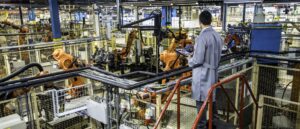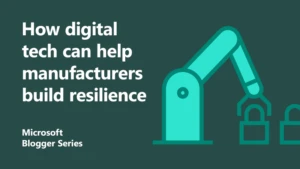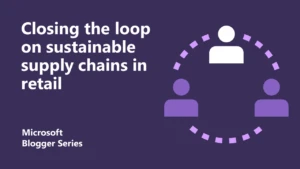
10 Tech Trends for 2016
It’s 2016 – a year to celebrate some of our favourite quadrennial events: we get to welcome back the leap year, and cheer on Team GB at the Summer Olympics in Rio. There will be great rejoicing among bean-counters everywhere, as the UN has designated 2016 the International Year of the Pulses. On the technology front, though, 2016 won’t be a year of new tech – per sey (if you are looking for way-out, speculative tech, may I suggest Future Visions, an anthology of short stories based on the work of Microsoft researchers from some of today’s top sci-fi writers). The stuff people talked about in 2015 will remain the stuff we talk about this year; in particular: the Internet of Things, Big Data, Ambient (machine) Learning and Cyber Security. Where we will see the greatest impact and innovation, though, will be at the intersection of these major waves of technology. 2016 will be all about confluence. Based on this premise, here are my top ten technology trends for 2016:
1. We’ll have more networked devices
 We, as consumers and business people, continue to accumulate more devices. Ironically enough, a decade ago, the vision was to combine everything (e.g., Blackberry, Palm Pilot, mobile phone & pager) into a single device. And for the most part we did. But now there are multiple “single devices” – many mobile options for how we communicate and work. More than half of information workers report using three or more devices for work, and that number continues to grow. In 2016 this will take the form of cross-category devices: laptops that act like tablets; phones that work like desktops; wearables perform like smart phones, and so on. It’s no wonder that by 2020 the average person can expect to have seven networked devices.
We, as consumers and business people, continue to accumulate more devices. Ironically enough, a decade ago, the vision was to combine everything (e.g., Blackberry, Palm Pilot, mobile phone & pager) into a single device. And for the most part we did. But now there are multiple “single devices” – many mobile options for how we communicate and work. More than half of information workers report using three or more devices for work, and that number continues to grow. In 2016 this will take the form of cross-category devices: laptops that act like tablets; phones that work like desktops; wearables perform like smart phones, and so on. It’s no wonder that by 2020 the average person can expect to have seven networked devices.
Because of the cloud, our phones, tablets and wearables have access to a vast amount of processing power and information. This raises the questions of how we, as individuals, integrate and work best across all of our devices, and how our organisations manage and integrate these devices to maintain security (a different trend discussed later) and maximise productivity.
2. These networked devices will “see” and do more
It’s not just that we’ll have more things. As computing power gets faster, cheaper and smaller, the existing features in your things will continue to improve, new features will continue to be added. For instance, think about how much better the photos you take with your mobile device today are than the photos you took just three years ago. The capability already exists for immersive 3D holographic experiences with your phone. In 2016 developers will make more devices within this medium, and apps that explore this medium.
While 2015 was the year that smart wearables became mainstream consumer devices, 2016 will be the year that developers fight it out to become dominant players for “share of wrist”. Because more and more of these devices will make their way into the workplace, it’ll also be there year that developers seek to turn wearables into productivity devices. This competition means our wearables will be more powerful with better sensors, monitors, accelerometers and GPS tracking tools to help make our experiences while wearing them more personal and more productive. For instance, your wearable will be able to interpret your heartrate and breathing to let your colleagues know if you’re feeling fatigued or productive, stressed or creative. The challenge will be finding ways, across our things, to utilise even a fraction of the capabilities in our things.
3. Our things will have more things
As it becomes easier (i.e. cheaper, faster, smaller) to add more features to our networked devices, it also becomes easier to add more features to previously unconnected things. It is now economically viable, for instance, for laundry services to add sensors to bedsheets to reduce loss and better anticipate when they need to be replaced. Farmers can now monitor livestock with sensors similar to those in our smartwatches that can diagnose disease or help optimise feed, growth and yield. Assisted living facilities can monitor residents based on a number of sensors in their rooms to determine, for instance, if a resident has had a fall or is a risk of causing a fire. The real value in connecting these things to a network comes from how these things then communicate and coordinate with each other without human intervention.
4. All these things will create a lot of data
Of course, the natural bi-product of a) having more networked devices that do more, and b) creating networked devices from previously unconnected things is data. Loads and loads of data. Expect to see the trend of exponential data growth continue in 2016. Mobile data traffic will continue to keep pace with the 57% CAGR predicted through 2019. And should pass the that’s zettabyte (that’s 1,000,000 terabytes) threshold for global IP traffic by year’s end. For perspective, that’s over 80 times the data created by the sum of all human-created information before the year 2000. By 2020, that’s expected to reach 44 zettabytes – roughly the data storage required to record every word ever spoken by humans throughout history.
But it’s not just about the amount of data we produce, but also in the types we produce as well (new sensors, new or newly-networked devices, new social platforms, etc). We’ll also have to manage the speed with which new data is being produced (and therefore processed) and the speed (some say voracity) with which business decision-makers want to turn that data into insight. And we’re not doing a particularly good job of it. Depending on whom you ask, we’re only able to analyse about 0.5% the data we produce. That percentage goes up a bit if we look at the ability for companies to analyse the data they have – but only up to about 12%. Which brings us to the next prediction for 2016.
5. The skill gap for turning that data into insight and business process will separate winners from losers
The gap between our demand for data (or for insight from data) and the supply of talent that can interpret it isn’t new for 2016. It’s been a high priority among CIOs for at least the past five years, and it’s the reason that Data Scientist has been dubbed the Sexiest Job of the 21st century. It’s also the reason why companies have been willing to shell out loads to find top talent. What’s new for 2016, though, is the impact that early investments in analytics will start to pay off as the use of data becomes a competitive differentiator.
This isn’t just due to the creation of the data scientist role within an organisation, but rather because these individuals have had an opportunity to impact other parts of an organisation helping to turn data sceptics into data evangelists. As data scientists (or power BI users, business analysts or whatever other term you call them) have helped to familiarise other business decision-makers with the benefits of data-driven decision-making, the tools used to interpret data have become easier for non-data scientists to use. These factors, among others, help to create data winners and losers. At the worldwide level, those winners (i.e. leaders) will capture £1.1 trillion more in value from their data and analytics investments over the next few years than the losers (“others”).
6. The winners will be the ones who create the algorithms that turn that data into insight and process
It isn’t enough, though, for this data to drive business decisions. Even the most sophisticated predictive analytics rely on users within an organisation turning that insight into action. The next logical step (and the next big thing for 2016) is to develop proprietary algorithms that allow companies to turn data into autonomous action. Or as senior Gartner researchers describe it “how you do something with data, not just what you do with it.” Don’t worry, it’s not as scary as it sounds. The machines aren’t rising up.
Rather than Terminator, think of algorithms from Netflix used to serve up movie recommendations, or from The Associated Press used to curate information into articles and reports. But the algorithm economy isn’t just about serving up digital content. The algorithm for Google’s driverless car incorporates data from the physical (internal sensors and systems, readings of physical surroundings, GPS data, etc…) for an incredibly complex autonomous action – driving. Norway’s eSmart system collects a huge volume of data from previously non-networked meters, building sensors and a variety of other sources (a true example of big data). But it’s what it does with that data that sets it apart. Their algorithms enable their automated demand response solution to automatically control power load to buildings or other infrastructure to prevent outages.
7. Machines will understand how we work more
These algorithms aren’t static things, though. As they make their way into more systems, and are programmed to learn more about the data they process, the smarter they become. The better they become at anticipating our needs, as individuals or as organisations. Take Clutter, for instance. This feature in Office 365 utilises machine learning to understand your organisational relationships and prioritise your inbox by importance to you. Microsoft has made the underlying machine learning that enables features like Clutter available to the developer community to create their own machine learning applications to everything from rating one’s Movember moustache to predicting customer churn.
Because of this availability, machine learning applications will take off in 2016 – both in terms of volume and sophistication. Nowhere will that growth be more evident than with the increased importance of virtual personal assistant technology such as Cortana, which will help to curate the many disparate productivity apps we currently use. For instance, machine learning will allow the product marketing manager of a consumer packaged goods company to ask “Why is there a spike for laundry soap in Leeds?” The right machine learning app would be able to understand contextually who within the organisation would be likely to have the answer and help her find the territory manager for West Yorkshire. The app would also be able to evaluate known sales influence models using the context of Leeds, against relevant data sources to try to identify the reason for the spike.
8. Machines will understand our businesses more
The same technology that will enable virtual personal assistants to curate information for individuals’ productivity in 2016, will also power smarter interactions between organisations. As more data is managed in the cloud, it becomes easier for companies to securely share information with each other, and turn that information into action/business processes.
Expect 2016 to be the year we begin to see machine learning applied to massive datasets across organisations. This could be from sectors (e.g. pharmaceuticals and medical research sharing information on human genomic data) or complementary supply chains (e.g., an aeroplane manufacturer applying machine learning in partnership with airlines and parts manufacturers).
9. Each new networked node creates new vulnerabilities
While we’ll see increased data sharing and automation of the way we make sense of our data across industries, we’ll also see increased vulnerabilities. For each new node we add to the cloud – for each previously non-networked device that gets “smart” or for each bit of shared data across organisations, we exponentially increase the risk to the overall network. In 2016, expect to see successful companies refining their data security strategy to account for these threats. Interestingly enough, a few of the previously mentioned trends – machine learning and advanced algorithms – will be key to maintain security.
10. I will be wrong:
Granted, the above is a fairly predictable set of predictions. The four big mega-trends of the past few years (IoT, Big Data, Machine Learning and Cyber Security) will continue to drive the majority of the technology discussion, I’m almost certain that there will be a breakthrough trend in 2016 that isn’t discussed above. Adoption of a nascent technology will be faster or the big strides expected within the above trends won’t materialise as expected. For instance, interactive headsets such as HoloLens or Oculus Rift might gain widespread adoption through a major commercial breakthrough. Conversely, the dearth of data scientists may limit the degree to which the algorithm economy takes hold.
Are you ready for 2016?
However these big trends shake out in 2016, though, the one strand that runs through all of them is data. How prepared are you make the most of your data? Have you thought through all the sources of data your organisation will come in contact with? Do you have the right people and systems in place to take advantage of the algorithm economy and machine learning? Have you thought through the security and vulnerabilities around your data?
A good starting point for answering these questions, and understanding how they all interrelate is through Microsoft’s Data Culture Immersion Series. These customer events are delivered in conjunction with a host of leading Microsoft partners to provide a series of half day and full day sessions specific to your needs.




